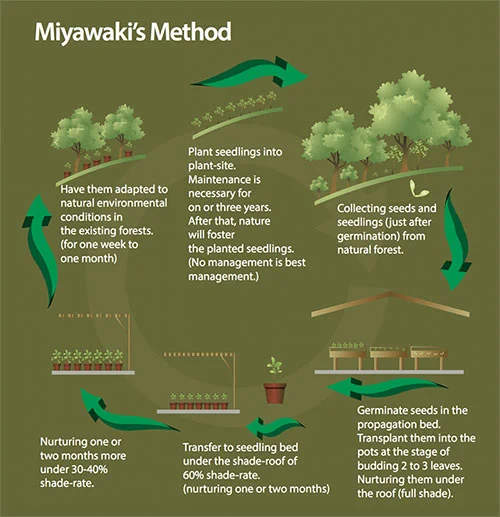Date : 21/06/2023
Relevance – GS Paper 3 - Environment and Ecology – Urban Forestry
Key Words – Miyawaki plantation method, Indigenous trees, Dense green cover, Barren spaces, Urban forests
Context –
In a recent episode of 'Mann ki Baat,' the Prime Minister of India highlighted the Miyawaki plantation method, which involves establishing dense urban forests in limited spaces. He shared insights into this Japanese technique and the inspiring story of Raafi Ramnath, a teacher from Kerala, who successfully utilized the Miyawaki method to transform a barren piece of land into a thriving miniature forest named Vidyavanam.
The Miyawaki Plantation Method:
Overview:
The Miyawaki method, named after Japanese botanist Akira Miyawaki, focuses on planting two to four different types of indigenous trees within every square meter of land. Developed in the 1970s, this technique aims to create a dense green cover within small parcels of land. The trees planted using this method become self-sustaining and reach their full length within three years. Moreover, the indigenous plants used in Miyawaki forests are low-maintenance, requiring minimal attention in terms of watering and manuring.
Significance:
The dense green cover formed by indigenous trees through the Miyawaki method plays a crucial role in absorbing dust particles and regulating surface temperatures in the area. Additionally, these forests promote the growth of new biodiversity and contribute to the fertility of the soil. Common indigenous plants such as Anjan, Amala, Bel, Arjun, and Gunj are often utilized in Miyawaki forests.
Miyawaki Forest Method in Mumbai:
The cost-effective Miyawaki Plantation Method has gained popularity as a solution to restore green cover in space-starved cities like Mumbai. The Brihanmumbai Municipal Corporation (BMC) has implemented Miyawaki forests in various vacant areas of the city to combat climate change, reduce pollution levels, and enhance the greenery. To date, 64 Miyawaki forests have been successfully planted in Mumbai.
Conclusion:
The Miyawaki plantation method offers a remarkable approach to transform barren spaces into miniature forests, even in urban settings with limited land availability. Its ability to create dense green cover, promote biodiversity, and contribute to soil fertility makes it an effective tool in combating climate change and enhancing the overall environmental health of an area. The successful implementation of Miyawaki forests, both by individuals like Raafi Ramnath and by government bodies like the BMC in Mumbai, showcases the potential for widespread adoption of this method across the country.
Probable Questions for Mains Examination
- Discuss the significance of the Miyawaki plantation method in transforming barren spaces into miniature forests. How does it contribute to biodiversity conservation and soil fertility? (10 Marks, 150 Words)
- Analyze the implementation of Miyawaki forests in Mumbai as a solution to combat climate change and enhance green cover. Examine the benefits and challenges of adopting the Miyawaki plantation method in densely populated urban areas. (15 Marks, 250 Words)
Source – Business Standard








